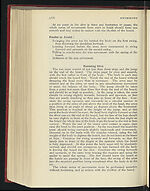1939-40
(593)
Download files
Complete book:
Individual page:
Thumbnail gallery: Grid view | List view

G
e
e
9
e
lv
SWIMMING
567
Faults to
Avoid
:
Lack of smoothness and confidence in the run.
Running straight off the board without waiting for the spring.
Swinging the arms wildly without proper control.
Failing to synchronise the swing of the arms with the spring of
the board.
Leaning forward when alighting on the board for the last time.
There is always a tendency, particularly when diving from a
spring board immediately after diving from a fixed board, for
the body to enter the water at an angle beyond the vertical.
This is invariably due to the diver allowing the spring in the
board to throw his feet and legs up, instead of the whole of the
body. The line of the body at the moment the toes leave the
board should never be more than zo degrees from the vertical.
The muscles round the hips must be very firmly braced, to
prevent the body bending at the hips.
General
A dive is always considered as a whole rather than as a continuous
execution of its several parts. There are, therefore, important points
to observe which cannot be confined to any one of the parts dealt
with above.
Throughout the whole of the dive the body and limbs must be
completely and obviously under intelligent control. There must
never be any slackness or deadness. The body must never look
as though it were falling or dropping into the water. On the other
hand, undue straining to get into or hold a position should never
be apparent.
The body should never enter the water at an angle beyond the
vertical.
The body and limbs must not crumple during the flight or on
entry into the water, but must be braced, particularly on the entry,
to withstand the impact of the water.
e
e
9
e
lv
SWIMMING
567
Faults to
Avoid
:
Lack of smoothness and confidence in the run.
Running straight off the board without waiting for the spring.
Swinging the arms wildly without proper control.
Failing to synchronise the swing of the arms with the spring of
the board.
Leaning forward when alighting on the board for the last time.
There is always a tendency, particularly when diving from a
spring board immediately after diving from a fixed board, for
the body to enter the water at an angle beyond the vertical.
This is invariably due to the diver allowing the spring in the
board to throw his feet and legs up, instead of the whole of the
body. The line of the body at the moment the toes leave the
board should never be more than zo degrees from the vertical.
The muscles round the hips must be very firmly braced, to
prevent the body bending at the hips.
General
A dive is always considered as a whole rather than as a continuous
execution of its several parts. There are, therefore, important points
to observe which cannot be confined to any one of the parts dealt
with above.
Throughout the whole of the dive the body and limbs must be
completely and obviously under intelligent control. There must
never be any slackness or deadness. The body must never look
as though it were falling or dropping into the water. On the other
hand, undue straining to get into or hold a position should never
be apparent.
The body should never enter the water at an angle beyond the
vertical.
The body and limbs must not crumple during the flight or on
entry into the water, but must be braced, particularly on the entry,
to withstand the impact of the water.
Set display mode to:
![]() Universal Viewer |
Universal Viewer | ![]() Mirador |
Large image | Transcription
Mirador |
Large image | Transcription
| Games and sports in the army > 1939-40 > (593) |
|---|
| Permanent URL | https://digital.nls.uk/248753909 |
|---|
| Description | 'Games and Sports in the Army' was an annual publication produced by the British War Office between the 1930s and 1960s. This included the Second World War. It outlines the rules and regulations for games and sports played by members of the armed forces. It features names and photographs of team members, and examples of contemporary advertising. |
|---|---|
| Shelfmark | GWB.52 |

